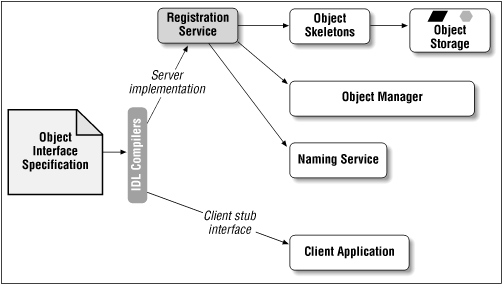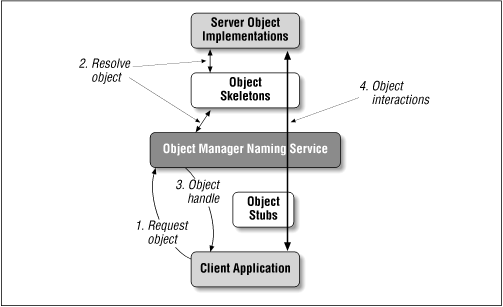 | Chapter 3: Distributing Objects |  |

From our exercise in the previous section, we uncovered some of the features that distributed object systems need. These features, plus some others, are illustrated in Figure 3-1. An object interface specification is used to generate a server implementation of a class of objects, an interface between the object implementation and the object manager, sometimes called an object skeleton, and a client interface for the class of objects, sometimes called an object stub. The skeleton will be used by the server to create new instances of the class of objects and to route remote method calls to the object implementation. The stub will be used by the client to route transactions (method invocations, mostly) to the object on the server. On the server side, the class implementation is passed through a registration service, which registers the new class with a naming service and an object manager, and then stores the class in the server's storage for object skeletons.

With an object fully registered with a server, the client can now request an instance of the class through the naming service. The runtime transactions involved in requesting and using a remote object are shown in Figure 3-2. The naming service routes the client's request to the server's object manager, which creates and initializes the new object using the stored object skeleton. The new object is stored in the server's object storage area, and an object handle is issued back to the client in the form of an object stub interface. This stub is used by the client to interact with the remote object.

While Figure 3-2 illustrates a client-server remote object environment, a remote object scheme can typically be used in a peer-to-peer manner as well. Any agent in the system can act as both a server and a client of remote objects, with each maintaining its own object manager, object skeleton storage, and object instance storage. In some systems the naming service can be shared between distributed agents, while in others each agent maintains its own naming service.
In the following sections we'll look at each element of this general distributed object architecture in more detail.
To provide a truly open system for distributing objects, the distributed object system should allow the client to access objects regardless of their implementation details, like hardware platform and software language. It should also allow the object server to implement an object in whatever way it needs to. Although in this book we are talking about implementing systems in Java, you may have valuable services already implemented in C, C++, or Smalltalk, and these services might be expensive to reimplement in Java. In this situation you'd like the option of wrapping your existing services with object interfaces and using them directly via the remote object system.
Some distributed object systems provide a platform-independent means for specifying object interfaces. These object interface descriptions can be converted into server skeletons, which can be compiled and implemented in whatever form the server requires. The same object interfaces can be used to generate client-side stub interfaces. If we're dealing with a Java-based distributed system, then the server skeletons and client stubs will be generated as Java class definitions, which will then be compiled into bytecodes.
In CORBA, object interfaces are described using a platform-independent language called the Interface Definition Language (IDL). Other similar languages are the Interface Specification Language (ISL) in Xerox's Inter-Language Unification (ILU) system, and the Distributed Component Object Model (DCOM, comprised of COM and an extended version of DCE-RPC) used in Microsoft's DCOM system.
The object manager is really at the heart of the distributed object system, since it manages the object skeletons and object references on an object server. The object manager plays a role similar to that of an Object Request Broker (ORB) in a CORBA system, or the registry service in RMI, both of which will be discussed in more detail shortly. When a client asks for a new object, the object manager locates the skeleton for the class of object requested, creates a new object based on the skeleton, stores the new object in object storage, and sends a reference to the object back to the client. Remote method calls made by the client are routed through the manager to the proper object on the server, and the manager also routes the results back to the client. Finally, when the client is through with the remote object, it can issue a request to the object manager to destroy the object. The manager removes the object from the server's storage and frees up any resources the object is using.
Some distributed object systems support things like dynamic object activation and deactivation, and persistent objects. The object manager typically handles these functions for the object server. In order to support dynamic object activation and deactivation, the object manager needs to have an activation and deactivation method registered for each object implementation it manages. When a client requests activation of a new instance of an interface, for example, the object manager invokes the activation method for the implementation of the interface, which should generate a new instance. A reference to the new instance is returned to the client. A similar process is used for deactivating objects. If an object is set to be persistent, then the object manager needs a method for storing the object's state when it is deactivated, and for restoring it the next time a client asks for the object.
Depending on the architecture of the distributed object system, the object manager might be located on the host serving the objects, or its functions might be distributed between the client and the server, or it might reside completely on a third host, acting as a liaison between the object client and the object server.
The registration/naming service acts as an intermediary between the object client and the object manager. Once we have defined an interface to an object, an implementation of the interface needs to be registered with the service so that it can be addressed by clients. In order to create and use an object from a remote host, a client needs a naming service so that it can specify things like the type of object it needs, or the name of a particular object if one already exists on the server. The naming service routes these requests to the proper object server. Once the client has an object reference, the naming service might also be used to route method invocations to their targets.
If the object manager also supports dynamic object activation and persistent objects, then the naming service can also be used to support these functions. If a client asks the service to activate a new instance of a given interface, the naming service can route this request to an object server that has an implementation of that interface. And if an object manager has any persistent objects under its control, the naming service can be notified of this so that requests for the object can be routed correctly.
In order for the client to interact with the remote object, a general protocol for handling remote object requests is needed. This protocol needs to support, at a minimum, a means for transmitting and receiving object references, method references, and data in the form of objects or basic data types. Ideally we don't want the client application to need to know any details about this protocol. It should simply interact with local object interfaces, letting the object distribution scheme take care of communicating with the remote object behind the scenes. This minimizes the impact on the client application source code, and helps you to be flexible about how clients access remote services.
Of course, we'll need to develop, debug, and maintain the object interfaces, as well as the language-specific implementations of these interfaces, which make up our distributed object system. Object interface editors and project managers, language cross-compilers, and symbolic debuggers are essential tools. The fact that we are developing distributed systems imposes further requirements on these tools, since we need a reasonable method to monitor and diagnose object systems spread across the network. Load simulation and testing tools become very handy here as well, to verify that our server and the network can handle the typical request frequencies and types we expect to see at runtime.
As we have already mentioned, any network interactions carry the potential need for security. In the case of distributed object systems, agents making requests of the object broker may need to be authenticated and authorized to access elements of the object repository, and restricted from other areas and objects. Transactions between agents and the remote objects they are invoking may need to be encrypted to prevent eavesdropping. Ideally, the object distribution scheme will include direct support for these operations. For example, the client may want to "tunnel" the object communication protocol through a secure protocol layer, with public key encryption on either end of the transmission.

Copyright © 2001 O'Reilly & Associates. All rights reserved.